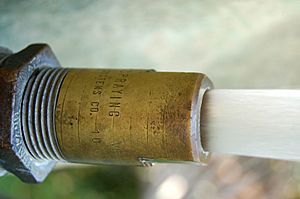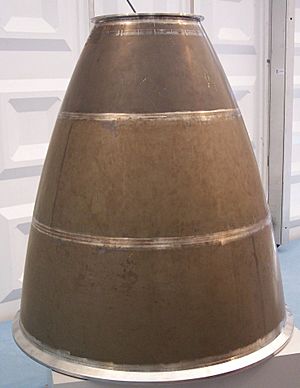Nozzle facts for kids
A nozzle is a special device that controls how a liquid or gas flows. It often makes the flow faster as it leaves a pipe or a closed space. Think of it like a funnel that can change the speed, direction, or shape of water or air coming out.
Nozzles are used in many everyday things. They can make a fluid stream stronger, wider, or more focused. When a fluid goes through a nozzle, its speed usually increases, but its pressure goes down.
Contents
What Do Nozzles Do?
Nozzles have many important jobs. They help us control liquids and gases in useful ways.
Creating Jets of Fluid
A jet is a strong, focused stream of gas or liquid coming out of a nozzle.
- Gas jets are used in things like gas stoves, ovens, and barbecues to direct the flame. Long ago, gas jets were even used for lighting rooms before electric lights were invented.
- Fluid jets are found in places like jacuzzis or spas, where they create powerful streams of water.
- Some special nozzles create a very smooth water stream called a laminar jet. This is useful for beautiful fountains.
- Foam jets are another type, used to spray foam instead of just liquid or gas.
- Nozzles called tuyeres are used to blow hot air into large furnaces or forges.
- In big buildings, jet nozzles are used in air conditioning systems. They help spread air evenly across large rooms, especially when regular vents won't work well.
Making Fluids Go Faster
One main goal of a nozzle is to make a fluid move much faster. This happens by changing the fluid's pressure into speed.
Convergent and Divergent Nozzles
Nozzles can have different shapes:
- A convergent nozzle gets narrower from a wide opening to a smaller one. It speeds up fluids that are moving slower than the speed of sound. If the pressure is high enough, the fluid can reach the speed of sound at the narrowest point. This is called being "choked."
- A divergent nozzle gets wider from a small opening to a larger one. It slows down fluids moving slower than the speed of sound, but it speeds up fluids already moving at or above the speed of sound.
Convergent-Divergent Nozzles
A special type is the convergent-divergent nozzle, also known as a "con-di nozzle" or de Laval nozzle. It starts narrow (convergent) and then gets wider (divergent). These nozzles are very important for things that need extreme speed, like rocket engines. They can take a fluid that has reached the speed of sound in the narrow part and accelerate it to even faster, supersonic speeds in the wider part. This design also helps push the gases straight backward, which creates the most power for movement.
Propelling Things Forward
Nozzles are key for creating thrust, which is the force that pushes things forward.
- Jet engines use propelling nozzles to shoot out hot, fast air. This creates the thrust that moves airplanes. Supersonic jets, like fighters or the Concorde, use convergent-divergent nozzles to get the very high speeds needed for supersonic flight.
- Rocket motors also use convergent-divergent nozzles. They need to push out gases at incredibly high speeds to lift off and travel through space.
Creating Sprays
Many nozzles are designed to turn liquids into a fine spray.
- Atomizer nozzles are used in things like spray paint cans, perfume bottles, and even in car engines to mix fuel with air.
- Air-aspirating nozzles are used with foam, like in fire extinguishers. They mix air into a liquid to make it foamy.
- Swirl nozzles make the liquid spin as it exits, creating a cone-shaped spray.
Vacuum Nozzles
Vacuum cleaners use different shapes of nozzles to suck up dirt and dust. These nozzles are designed to create a strong suction and pick up debris from various surfaces.
Shaping Materials
Some nozzles are used to shape materials. For example, in extrusion molding, a material like plastic or metal is pushed through a specially shaped nozzle called a die. This creates long pieces of material with a specific cross-section, like a tube or a specific profile.
See also
 In Spanish: Tobera para niños
In Spanish: Tobera para niños





